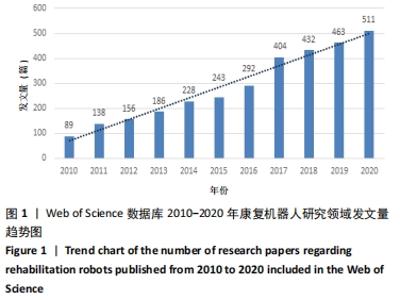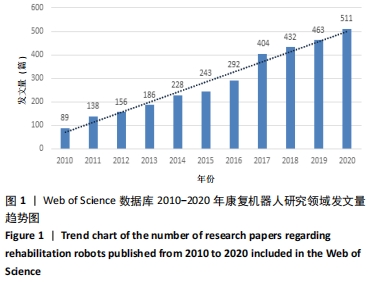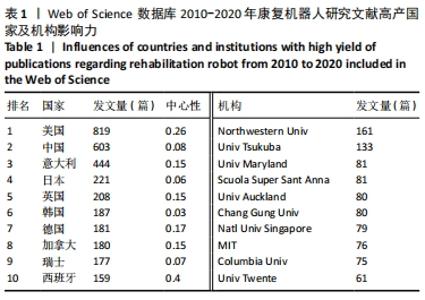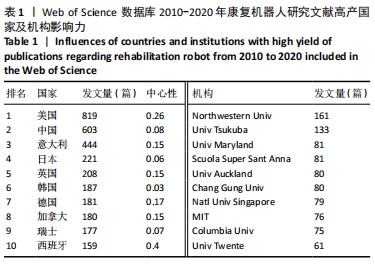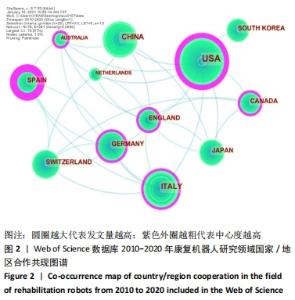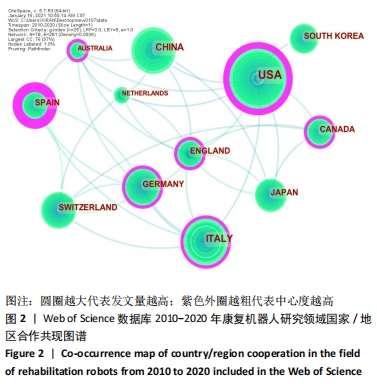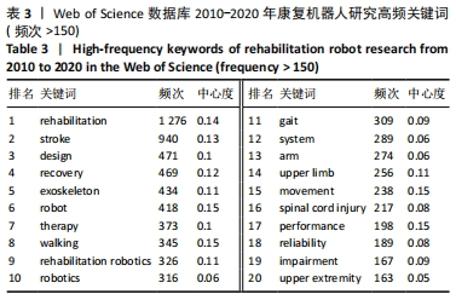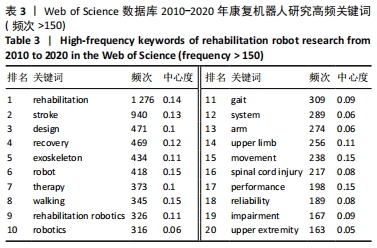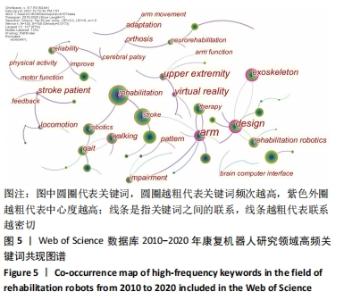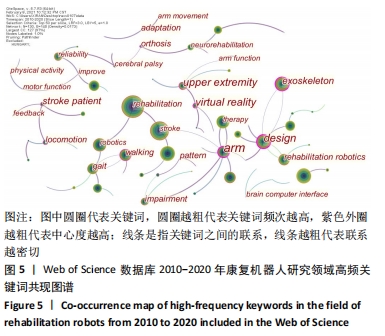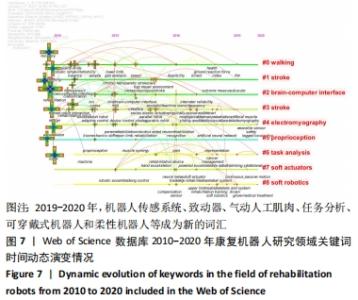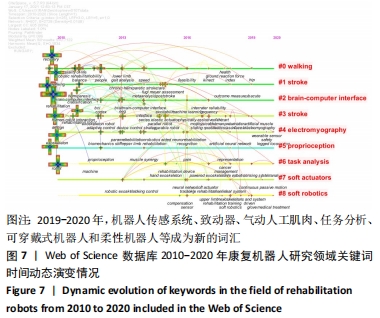Chinese Journal of Tissue Engineering Research ›› 2022, Vol. 26 ›› Issue (14): 2214-2222.doi: 10.12307/2022.486
Previous Articles Next Articles
Hot spots and frontiers of rehabilitation robot research in recent 10 years: a bibliometric analysis based on the Web of Science database
Xue Xiali1, Deng Zhongyi1, Sun Junzhi1, Li Ning1, Ren Wenbo2, Zhou Ling2, He Ye3
- 1Institute of Sports Medicine and Health, 2School of Sports Medicine and Health, Chengdu Sport University, Chengdu 610041, Sichuan Province, China; 3State Key Laboratory of Mechanical Transmission, Chongqing University, Chongqing 400044, China
-
Received:2021-01-18Revised:2021-02-27Accepted:2021-08-20Online:2022-05-18Published:2021-12-21 -
Contact:Li Ning, Associate professor, Institute of Sports Medicine and Health, Chengdu Sport University, Chengdu 610041, Sichuan Province, China -
About author:Xue Xiali, Master candidate, Institute of Sports Medicine and Health, Chengdu Sport University, Chengdu 610041, Sichuan Province, China -
Supported by:the National Key Research and Development Program of China, No. 2018YFF0300604; Sichuan Provincial Key Laboratory of Sports Medicine, No. 2021-A002 (to LN)
CLC Number:
Cite this article
Xue Xiali, Deng Zhongyi, Sun Junzhi, Li Ning, Ren Wenbo, Zhou Ling, He Ye. Hot spots and frontiers of rehabilitation robot research in recent 10 years: a bibliometric analysis based on the Web of Science database[J]. Chinese Journal of Tissue Engineering Research, 2022, 26(14): 2214-2222.
share this article
Add to citation manager EndNote|Reference Manager|ProCite|BibTeX|RefWorks
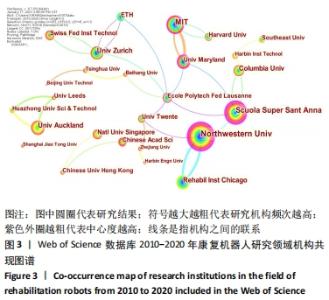
2.3 基于研究机构合作共现的研究热点分析 通过研究机构合作共现分析,使用Citespace软件绘制出康复机器人研究机构合作共现的研究热点视图,共生成411个节点,616条连接,拓扑网络的密度为0.007 3。研究机构可视化提示,中心度排名前3的分别是Scuola Super Sant Anna(比萨圣安娜高等学校,0.24)、Northwestern Univ(西北大学,0.23)和MIT(麻省理工学院,0.12),这3个机构均与其他机构建立了良好的研究合作关系。比萨市圣安娜高等学校仿生机器人研究院成立于2011年,经过近10年的发展,已在国际康复机器人研究中处于领先地位,重点开发仿生机器人、智能系统以及微电子技术研发与创新;2020年西北大学的研究人员开发出首个类似于生命的材料,可以充当软机器人,能以人类的速度行走,捡起物体并将其运输到新的位置,引起国际学术界的轰动;麻省理工学院作为较早进入辅助康复机器人研究的机构,研发出了适应于各类损伤类型的康复机器人,在国际上有较高的盛名和权威。由图可以看出,国际上研发水平较高的机构间合作密切,为康复机器人的发展做出了卓越的贡献,见图3。"
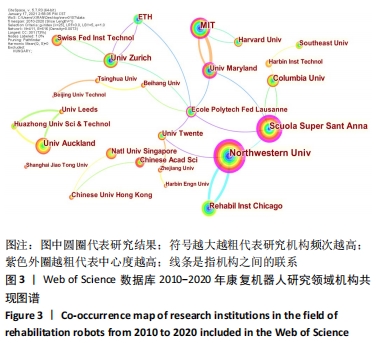

2.4 高影响力作者及合作关系分析 在作者合作关系图谱中,Riener R教授以绝对的优势,占据该领域的领头地位,但与其他发文量较高的作者无合作关系,其他几位高影响力作者间合作关系相对较密切。高影响力作者多进行频繁密切的交流合作,才能更好地推动国际康复机器人研究的发展。根据普赖斯定律[24],在同一主题中,半数的论文为一群高生产能力作者所撰,这一作者集合的数量上约等于全部作者总数的平方根。在3 194篇文献中,共有9 163位作者,其中,前93位作者就完成了50%的论文数量,符合普赖斯定律。说明已经形成了康复机器人领域的核心作者群,即关注这些作者的研究方向可以更好的了解康复机器人发展的前沿与趋势,见图4。"
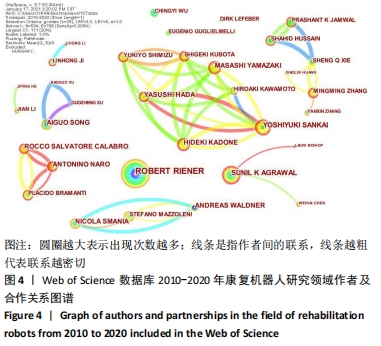
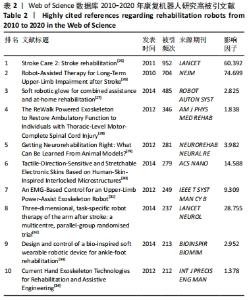
2.5 高被引文献分析 在检索到的3 194条文献中,文献总被引频次为47 224次,前3名来源期刊分别是《LANCET》(柳叶刀)、《NEJM》(新英格兰医学杂志)、《ROBOT AUTON SYST》(机器人和自主系统杂志)。但综合被引用频次、比例,文章质量均有待进一步提升。且高被引文献的发表时间均较早,可能是新的高质量的文献发表时间较晚,导致被引频次相对较低。第一的文章是脑卒中治疗的指南,康复实践的新疗法虚拟现实、机器人治疗等正在被越来越多的应用到临床中;第二、三篇介绍了康复机器人及软式手套在脑卒中患者的实际应用效果。可见,康复机器人不仅有指南规范,针对脑卒中开展的新技术、新材料仍在不断发展进步,学术界仍然充满了活力。排名前10的高被引文献见表2。"
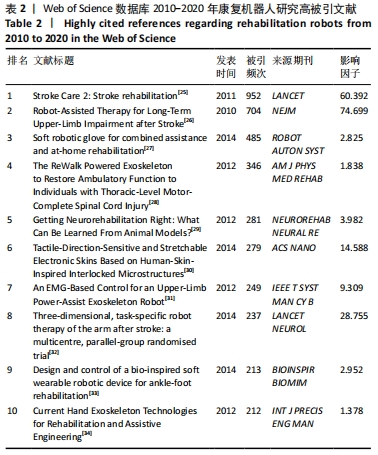
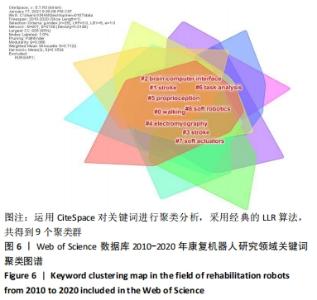
2.7 基于关键词聚类的研究热点及前沿分析 运用CiteSpace对关键词进行聚类分析,采用经典的LLR算法,共得到9个聚类群,分别为:#0 walking、#1 stroke、#2 brain-computer interface、#3 stroke、#4 electromyography、#5 proprioception、#6 task analysis、#7 soft actuators、#8 soft robotics,见图6。以Timeline view显示聚类关键词的时间动态变化。从2010年康复机器人、脑卒中、外骨骼、机器人的稳定性、脑卒中康复、脊髓损伤、神经康复、肌肉运动学习、虚拟现实等关键词得到广泛关注,其中,康复机器人与脑血管意外、外骨骼机器人、自适应控制和触觉手康复关系研究的热度2011年开始出现;康复机器人与脑机接口、上肢康复和Meta分析研究的热度2014年开始出现;康复机器人与上肢康复和Meta分析的关系研究热度持续到2019年;2019-2020年,机器人传感系统、致动器、气动人工肌肉、任务分析、可穿戴式机器人和柔性机器人等成为新的词汇。国际学术界对康复机器人相关研究热点的关注,反映了对康复机器人发展的极大关注。预测未来将围绕康复机器人与机器人传感系统、可穿戴式机器人和柔性机器人继续深入研究。关键词时间动态演变情况见图7。"
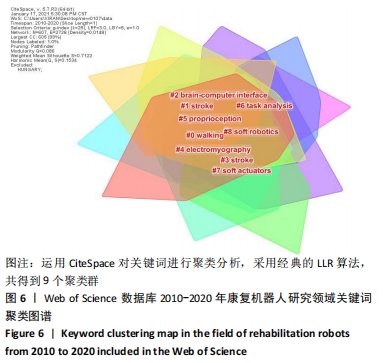
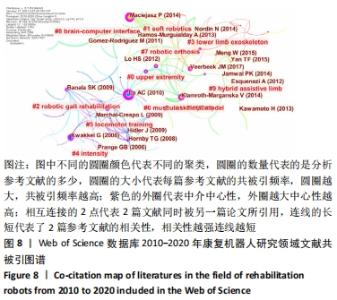
2.8 基于相关文献共被引聚类分析 通过文献共被引聚类分析,使用Citespace软件绘制出康复机器人研究文献共被引图谱,以最低被引次数为15次进行绘制,共生成10个聚类,134个节点,219条连接,拓扑网络的密度为0.024 6。图中不同的圆圈颜色代表不同的聚类;圆圈的数量代表的是分析参考文献的多少;圆圈的大小代表每篇参考文献的共被引频率,圆圈越大共被引频率越高;紫色的外圈代表中介中心性,外圈越大中心性越高。相互连接的两点代表两篇文献同时被另一篇论文所引用。连线的长短代表了2篇参考文献的相关性,相关性越强连线越短。中心度排在前3的高被引文献为“Lo AC,2010[35]”(0.88)、“Maciejasz P, 2014[36]”(0.68)、“Klamroth-Marganska V2014[32]”(0.45),第一篇介绍了对于脑卒中后长期上肢损伤的患者,机器人辅助疗法可明显改善上肢运动;第二篇总结了现有的上肢康复机器人治疗方案,对各种康复机器人系统中实施的技术解决方案进行了全面列表比较;第三篇评估了使用外骨骼机器人训练与传统疗法对于脑卒中患者上肢功能恢复疗效的比较。由此可见,康复机器人在脑卒中患者上肢功能康复的应用十分广泛,同时从侧面反映了脑卒中上肢功能康复是当前的热点研究领域,见图8。"
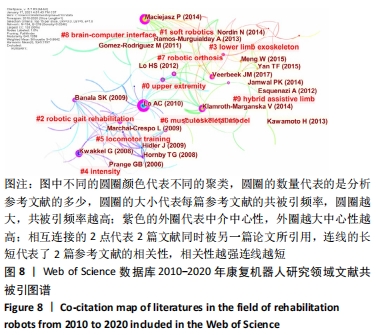
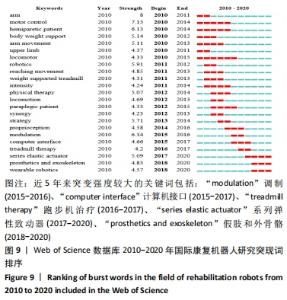
2.9 基于突现词检测算法的研究前沿分析 运用CiteSpace突现词探测功能,共探测到108个突变词。在被引文献频次最高的25个关键词中,有16个突变词的突变周期均集中在2010-2015年。突变强度最大的是“arm”上肢(8);其次是“motor control”机电控制(7.13);排在第三位的是“hemiparetic patient”脑卒中患者(6.13)。而近5年来突变强度较大的关键词包括:“modulation”调制(2015-2016)、“computer interface”计算机接口(2015-2017)、“treadmill therapy”跑步机治疗(2016-2017)、“series elastic actuator”系列弹性致动器(2017-2020)、“prosthetics and exoskeleton”假肢和外骨骼(2018-2020),见图9。系列弹性致动器主要应用于下肢动力假肢[37]。麻省理工学院在设计和制造动力假体方面研发出的仿生脚踝就属于此。关节可以模仿正常关节运动、补偿缺失肌肉的功能,将重量从其他肢体上移开,使得被截肢者可以依赖假肢运动,且该假肢适用于任何接触表面。外骨骼在最近几年特别流行,它在军事、医疗、民用等领域具有巨大的市场和前景。外骨骼机器人是一种特殊类型的康复机器人,主要用于辅助行走。目前,用于脑卒中康复的机器人外骨骼可以为用户提供一致的、高剂量的运动重复以及平衡和稳定性,因此受到了医疗人员及患者的青睐。"
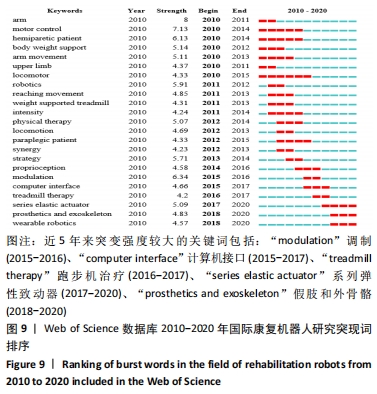
| [1] 李光林, 郑悦, 吴新宇, 等. 医疗康复机器人研究进展及趋势[J]. 中国科学院院刊,2015,30(6):793-802. [2] 林书, 胡豇, 万仑, 等. 骨科机器人辅助经皮椎体后凸成形治疗多节段脊柱转移瘤[J]. 中国组织工程研究,2020,24(33):5249-5254. [3] 喻洪流. 康复机器人:未来十大远景展望[J]. 中国康复医学杂志,2020, 35(8):900-902. [4] 王秋惠, 魏玉坤, 刘力蒙. 康复机器人研究与应用进展[J]. 包装工程, 2018,39(18):83-89. [5] 李宏伟, 张韬, 冯垚娟, 等. 外骨骼下肢康复机器人在脑卒中康复中的应用进展[J]. 中国康复理论与实践,2017,23(7):788-791. [6] RODGERS H, BOSOMWORTH H, KREBS HI, et al. Robot assisted training for the upper limb after stroke (RATULS): a multicentre randomised controlled trial. Lancet. 2019;394(10192):51-62. [7] BERNHARDT J, MEHRHOLZ J. Robotic-assisted training after stroke: RATULS advances science. Lancet. 2019;394(10192):6-8. [8] 励建安. 人机共融,天人合一——关于康复机器人应用与发展的思考[J]. 中国康复医学杂志,2020,35(8):897-899. [9] MEHRHOLZ J, HÄDRICH A, PLATZ T, et al. Electromechanical and robot-assisted arm training for improving generic activities of daily living, arm function, and arm muscle strength after stroke. Cochrane Database Syst Rev. 2012;(6):Cd006876. [10] NAM KY, KIM HJ, KWON BS, et al. Robot-assisted gait training (Lokomat) improves walking function and activity in people with spinal cord injury: a systematic review. J Neuroeng Rehabil. 2017;14(1):24. [11] LEFMANN S, RUSSO R, HILLIER S. The effectiveness of robotic-assisted gait training for paediatric gait disorders: systematic review. J Neuroeng Rehabil. 2017;14(1):1. [12] KREBS HI, VOLPE BT. Rehabilitation robotics. Handb Clin Neurol. 2013;110: 283-294. [13] KIM WS, CHO S, KU J, et al. Clinical Application of Virtual Reality for Upper Limb Motor Rehabilitation in Stroke: Review of Technologies and Clinical Evidence. J Clin Med. 2020;9(10):3369. [14] GORGEY AS. Robotic exoskeletons: The current pros and cons. World J Orthop. 2018;9(9):112-119. [15] MEKKI M, DELGADO AD, FRY A, et al. Robotic Rehabilitation and Spinal Cord Injury: a Narrative Review. Neurotherapeutics. 2018;15(3):604-617. [16] STOLLER O, DE BRUIN ED, SCHINDELHOLZ M, et al. Efficacy of Feedback-Controlled Robotics-Assisted Treadmill Exercise to Improve Cardiovascular Fitness Early After Stroke: A Randomized Controlled Pilot Trial. J Neurol Phys Ther. 2015;39(3):156-165. [17] 牛传欣, 崔立军, 鲍勇, 等. 上肢康复机器人用于神经康复的研究进展[J]. 中国康复医学杂志,2020,35(8):916-920. [18] 李文惠, 柳国斌. 国际糖尿病足研究知识图谱:基于CiteSpace的文献可视化分析[J]. 中国组织工程研究,2021,25(20):3178-3184. [19] 王梦婷, 古艳萍, 任文博, 等. 运动干预功能障碍人群血流限制训练的文献热点可视化分析[J]. 中国组织工程研究,2021,25(8):1264-1269. [20] LI XJ, LI CY, BAI D, et al. Insights into stem cell therapy for diabetic retinopathy: a bibliometric and visual analysis. Neural Regen Res. 2021; 16(1):172-178. [21] SUN W, HUANG P, SONG H, et al. Bibliometric analysis of acute pancreatitis in Web of Science database based on CiteSpace software. Medicine(Baltimore). 2020;99(49):e23208. [22] VAN HEDEL HJA, SEVERINI G, SCARTON A, et al. Advanced Robotic Therapy Integrated Centers (ARTIC): an international collaboration facilitating the application of rehabilitation technologies. J Neuroeng Rehabil. 2018;15(1):30. [23] PING X. Study of international anticancer research trends via co-word and document co-citation visualization analysis. Scientometrics. 2015;105(1): 611-622. [24] 张敏, 沈雪乐. 国际知识发现研究领域核心作者群成熟度分析[J]. 情报杂志,2014,33(8):111-116+122. [25] LANGHORNE PP, BERNHARDT PJ, KWAKKEL G. Stroke Care 2: Stroke rehabilitation. The Lancet. 2011;377(9778):1693-1702. [26] LO AC, GUARINO PD, RICHARDS LG, et al.Robot-assisted therapy for long-term upper-limb impairment after stroke. N Engl J Med. 2010;362(19): 1772-1783. [27] POLYGERINOS P, WANG Z, GALLOWAY KC, et al. Soft robotic glove for combined assistance and at-home rehabilitation. Robotics and Autonomous Systems. 2014;73(C):135-143. [28] ESQUENAZI A, TALATY M, PACKEL A, et al. The ReWalk powered exoskeleton to restore ambulatory function to individuals with thoracic-level motor-complete spinal cord injury. Am J Phys Med Rehabil. 2012;91(11):911-921. [29] KRAKAUER JW, CARMICHAEL ST, CORBETT D, et al. Getting neurorehabilitation right: what can be learned from animal models?. Neurorehabil Neural Repair. 2012;26(8):923-931. [30] PARK J, LEE Y, HONG J, et al. Tactile-direction-sensitive and stretchable electronic skins based on human-skin-inspired interlocked microstructures. Acs Nano.2014; 8(12): 12020-12029. [31] KIGUCHI K, HAYASHI Y. An EMG-Based Control for an Upper-Limb Power-Assist Exoskeleton Robot. IEEE Trans Syst Man Cybern B Cybern. 2012;42(4): 1064-1071. [32] KLAMROTH-MARGANSKA V, BLANCO J, CAMPEN K, et al. Three-dimensional, task-specific robot therapy of the arm after stroke: a multicentre, parallel-group randomised trial. Lancet Neurol. 2014;13(2):159-166. [33] PARK YL, CHEN BR, PÉREZ-ARANCIBIA NO, et al. Design and control of a bio-inspired soft wearable robotic device for ankle-foot rehabilitation. Bioinspir Biomim. 2014;9(1):016007. [34] HEO P, GU GM, LEE SJ, et al. Current hand exoskeleton technologies for rehabilitation and assistive engineering. International Journal of Precision Engineering & Manufacturing. 2012;13(5):807-824. [35] LO AC, GUARINO PD, RICHARDS LG, et al. Robot-assisted therapy for long-term upper-limb impairment after stroke. N Engl J Med. 2010;362(19):1772-1783. [36] MACIEJASZ P, ESCHWEILER J, GERLACH-HAHN K, et al. A survey on robotic devices for upper limb rehabilitation. J Neuroeng Rehabil. 2014;11:3. [37] GRABOWSKI AM, D’ANDREA S. Effects of a powered ankle-foot prosthesis on kinetic loading of the unaffected leg during level-ground walking. J Neuroeng Rehabil. 2013;10:49. [38] MUSK E. An Integrated Brain-Machine Interface Platform With Thousands of Channels. J Med Internet Res. 2019;21(10):e16194. [39] PISARCHIK AN, MAKSIMENKO VA, HRAMOV AE. From Novel Technology to Novel Applications: Comment on “An Integrated Brain-Machine Interface Platform With Thousands of Channels” by Elon Musk and Neuralink. J Med Internet Res. 2019;21(10):e16356. [40] NOVAK D, RIENER R. Sensor Fusion in Assistive and Rehabilitation Robotics. Sensors (Basel). 2020;20(18):5235. [41] HAUFE FL, SCHMIDT K, DUARTE JE, et al. Activity-based training with the Myosuit: a safety and feasibility study across diverse gait disorders. J Neuroeng Rehabil. 2020;17(1):135. [42] VALERO-CUEVAS FJ, KLAMROTH-MARGANSKA V, WINSTEIN CJ, et al. Robot-assisted and conventional therapies produce distinct rehabilitative trends in stroke survivors. J Neuroeng Rehabil. 2016;13(1):92. [43] GUIDALI M, KELLER U, KLAMROTH-MARGANSKA V, et al. Estimating the patient’s contribution during robot-assisted therapy. J Rehabil Res Dev. 2013; 50(3):379-394. [44] JUST F, ÖZEN Ö, TORTORA S, et al. Human arm weight compensation in rehabilitation robotics: efficacy of three distinct methods. J Neuroeng Rehabil. 2020;17(1):13. [45] ZENG H, SHEN Y, HU X, et al. Semi-Autonomous Robotic Arm Reaching With Hybrid Gaze-Brain Machine Interface. Front Neurorobot. 2019;13:111. [46] PAN L, ZHAO L, SONG A, et al. A Novel Robot-Aided Upper Limb Rehabilitation Training System Based on Multimodal Feedback. Front Robot AI. 2019;6:102. [47] PAN L, SONG A, DUAN S, et al. Patient-Centered Robot-Aided Passive Neurorehabilitation Exercise Based on Safety-Motion Decision-Making Mechanism. Biomed Res Int. 2017;2017:4185939. [48] PAN L, SONG A, WANG S, et al. Experimental Study on Upper-Limb Rehabilitation Training of Stroke Patients Based on Adaptive Task Level: A Preliminary Study. Biomed Res Int. 2019;2019:2742595. [49] 陈悦, 宋超, 周京生, 等. 文献计量学视角下的论文被引频次影响因素研究——兼评使用与被引之间关系[J]. 情报杂志,2019,38(4):96-104. [50] 杨晗, 李涓, 徐桂兴, 等. 国际近15年太极拳研究的文献计量及可视化分析[J]. 中国康复医学杂志,2020,35(3):327-332. [51] MEHRHOLZ J, POLLOCK A, POHL M, et al. Systematic review with network meta-analysis of randomized controlled trials of robotic-assisted arm training for improving activities of daily living and upper limb function after stroke. J Neuroeng Rehabil. 2020;17(1):83. [52] DOWNEY JE, BRANE L, GAUNT RA, et al. Motor cortical activity changes during neuroprosthetic-controlled object interaction. Sci Rep. 2017;7(1):16947. [53] DONATI AR, SHOKUR S, MORYA E, et al. Long-Term Training with a Brain-Machine Interface-Based Gait Protocol Induces Partial Neurological Recovery in Paraplegic Patients. Sci Rep. 2016;6:30383. [54] SCHICKETMUELLER A, LAMPRECHT J, HOFMANN M, et al. Gait Event Detection for Stroke Patients during Robot-Assisted Gait Training. Sensors (Basel). 2020;20(12):3399. [55] SHI T, TIAN Y, SUN Z, et al. A New Projected Active Set Conjugate Gradient Approach for Taylor-Type Model Predictive Control: Application to Lower Limb Rehabilitation Robots With Passive and Active Rehabilitation. Front Neurorobot. 2020;14:559048. [56] SALMINGER S, MAYER JA, STURMA A, et al. [Exoprosthetic Replacement of the Upper Extremity]. Z Orthop Unfall. 2016;154(4):411-424. [57] THOMAS N, UNG G, MCGARVEY C, et al. Comparison of vibrotactile and joint-torque feedback in a myoelectric upper-limb prosthesis. J Neuroeng Rehabil. 2019;16(1):70. [58] MOLTENI F, GASPERINI G, GAFFURI M, et al. Wearable robotic exoskeleton for overground gait training in sub-acute and chronic hemiparetic stroke patients: preliminary results. Eur J Phys Rehabil Med. 2017;53(5):676-684. [59] NOLAN KJ, KARUNAKARAN KK, CHERVIN K, et al. Robotic Exoskeleton Gait Training During Acute Stroke Inpatient Rehabilitation. Front Neurorobot. 2020;14:581815. [60] ZHANG X, CHAN FK, PARTHASARATHY T, et al. Modeling and simulation of complex dynamic musculoskeletal architectures. Nat Commun. 2019;10(1): 4825. |
| [1] | Li Zhiyi, He Pengcheng, Bian Tianyue, Xiao Yuxia, Gao Lu, Liu Huasheng. Bibliometric and visualized analysis of ferroptosis mechanism research [J]. Chinese Journal of Tissue Engineering Research, 2022, 26(8): 1202-1209. |
| [2] | Zhao Jing, Liu Xiaobo, Zhang Yue, Zhang Jiaming, Zhong Dongling, Li Juan, Jin Rongjiang. Visualization analysis of neuromuscular electrical stimulation therapy based on CiteSpace: therapeutic effects, hot spots, and developmental trends [J]. Chinese Journal of Tissue Engineering Research, 2022, 26(8): 1234-1241. |
| [3] | Xu Jie, Zhou Wenqi, Luo Xiaobing. Visual analysis of patellofemoral pain syndrome research hotspots and content [J]. Chinese Journal of Tissue Engineering Research, 2022, 26(12): 1877-1887. |
| [4] | Wang Mengting, Gu Yanping, Ren Wenbo, Qin Qian, Bai Bingyi, Liao Yuanpeng. Research hotspots of blood flow restriction training for dyskinesia based on visualization analysis [J]. Chinese Journal of Tissue Engineering Research, 2021, 25(8): 1264-1269. |
| [5] | Luo Lin, Song Naiqing, Huang Jin, Zou Xiaodong. Review and prospect of international research on preschool children’s movement development assessment: a CiteSpace-based visual analysis [J]. Chinese Journal of Tissue Engineering Research, 2021, 25(8): 1270-1276. |
| [6] | Wu Zijian, Hu Zhaoduan, Xie Youqiong, Wang Feng, Li Jia, Li Bocun, Cai Guowei, Peng Rui. Three-dimensional printing technology and bone tissue engineering research: literature metrology and visual analysis of research hotspots [J]. Chinese Journal of Tissue Engineering Research, 2021, 25(4): 564-569. |
| [7] | Zhang Jiaming, Tian Yanping, Zhang Yue, Zhong Dongling, Li Yuxi, Zheng Zhong, Li Juan, Jin Rongjiang. Visual analysis of literature on transcranial magnetic stimulation for stroke based on Citespace knowledge map [J]. Chinese Journal of Tissue Engineering Research, 2021, 25(35): 5610-5618. |
| [8] | Guo Wen, Leng Jun, Liu Huimin, Zhang Chen, Fang Xiaolei, Wei Fangyue. Visual analysis of literature regarding post-stroke urinary incontinence in the past 10 years [J]. Chinese Journal of Tissue Engineering Research, 2021, 25(35): 5676-5681. |
| [9] | Hui Xiaoshan, Zhang Jinsheng, He Qingyong, Wang Shiqi, Yang Shuai, Zhang Hui, Wang Jie. Cardiomyocyte direct reprogramming: a scientometric and visualization analysis based on the Web of Science [J]. Chinese Journal of Tissue Engineering Research, 2021, 25(32): 5123-5131. |
| [10] | Bai Fuyu, Wang Mengqi, Xue Feng, Li Zhenrui, Yan Qinghao, Zhang Zhiyi, Wang Feng. Characteristics of randomized controlled trials on acupuncture for stress urinary incontinence in women [J]. Chinese Journal of Tissue Engineering Research, 2021, 25(32): 5197-5203. |
| [11] | Li Qiujiang, Fang Xiaomin, Wang Yinbin, Hu Xuehua, Cai Lijun. Current states and tendency of stem cells in the treatment of intervertebral disc degeneration: bibliometric analysis [J]. Chinese Journal of Tissue Engineering Research, 2021, 25(31): 5000-5011. |
| [12] | Xiong Binglang, Lin Tianye, Yang Peng, Xu Jingli, Zou Qizhao, Lai Qizhong, Zhang Qingwen. Visualization of global status and trends in anterior cruciate ligament reconstruction [J]. Chinese Journal of Tissue Engineering Research, 2021, 25(29): 4656-4663. |
| [13] | Lu Yuyun, Huang Mei, Shi Xinlei, Chen Baoyan. Bibliometric and visualization analysis of breast cancer stem cell literature from 2011 to 2020 based on Web of Science database [J]. Chinese Journal of Tissue Engineering Research, 2021, 25(25): 4001-4008. |
| [14] | Fan Jin, Zeng Luyao, Zhong Dongling, Li Yuxi, Tian Yanping, Huang Yijie, Jin Rongjiang. Development of functional near-infrared spectroscopy in recent 10 years: a visual analysis using CiteSpace [J]. Chinese Journal of Tissue Engineering Research, 2021, 25(23): 3711-3717. |
| [15] | Yang Qin, Zhou Honghai, Chen Longhao, Zhong Zhong, Xu Yigao, Huang Zhaozhi. Research status and development trend of pelvic reconstruction techniques: a bibliometric and visual analysis [J]. Chinese Journal of Tissue Engineering Research, 2021, 25(23): 3718-3724. |
| Viewed | ||||||
|
Full text |
|
|||||
|
Abstract |
|
|||||
